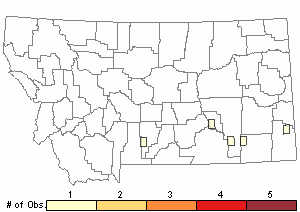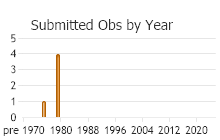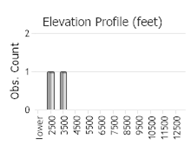View in other NatureServe Network Field Guides
NatureServe
Montana
Utah
Wyoming
Idaho
Wisconsin
British Columbia
South Carolina
Yukon
California
New York
Dun Skipper - Euphyes vestris
Native Species
Global Rank:
G5
State Rank:
S5
Agency Status
USFWS:
USFS:
BLM:
External Links
General Description
[From Ferris and Brown 1981; Scott 1986; Opler and Wright 1999; Glassberg 2001; Pyle 2002] Forewing 1.4-1.5 cm. Face and top of thorax golden-orange to gold-green, undersurface of head, front legs, thorax often white, wing fringes brownish, wings pointed. Uppersurface violet brown or dark brown all over, male with black stigma, female forewing with up to two tiny diffuse white spots near center, the inner spot half moon-shaped.
Phenology
One flight, mostly July in the north and west, June in southern California; two flights in the southeast, late may to early September; many flights in Florida, March to December (Scott 1986). One brood areas, mid-May to early September; two brood areas, May through September (Glassberg 2001). Late June to mid-August in Canada (Layberry et al. 1998). Mid-June through July in the Rocky Mountain states (Ferris and Brown 1981). Early June to late August in Colorado (Scott and Scott 1978; Scott and Epstein 1987), late June to early August in western Nebraska (Johnson and Nixon 1967), late June to late August in North Dakota (McCabe and Post 1976), late May to early September in Oregon and Washington (Pyle 2002; Warren 2005), late June to mid-August in British Columbia (Guppy and Shepard 2001).
Diagnostic Characteristics
Best determined by a combination of pointed wings, overall dark brown, face and top of thorax golden-orange to gold-green, uppersurface of male with black stigma, female forewing with up to two tiny diffuse white spots near center, the inner spot half moon-shaped.
Species Range
Montana Range
Range Descriptions

 Native
Native
Range Comments
Southern British Columbia south to northern and coastal-southern California, from east-central Alberta, Idaho, southern Montana through eastern Wyoming, Colorado, southwestern Utah to eastern Arizona, New Mexico, western Texas, northern Mexico, absent from much of intermountain West; also in the East across southern Canada south throughout the eastern US (Ferris and Brown 1981; Scott 1986; Opler and Wright 1999; Glassberg 2001). Typically below 2438 m elevation in the Rocky Mountain states (Ferris and Brown 1981), 1768 m to 2743 m elevation (usually below 2591 m) in Colorado (Brown 1957; Scott and Scott 1978), near sea level to about 1524 m elevation in Oregon (Warren 2005). In Montana, reported from at least 6 counties in the southeast 1/4 of the state, as far west as Sweet Grass County (Kohler 1980; Stanford and Opler 1993; FLMNH Lepidopterists' Society database), typically below 1524 m elevation. Mainly uncommon to locally common, locally rare in southern California and Saskatchewan (Glassberg 2001).
Observations in Montana Natural Heritage Program Database
Number of Observations: 5
(Click on the following maps and charts to see full sized version)
Map Help and Descriptions
Relative Density

Recency



 (Observations spanning multiple months or years are excluded from time charts)
(Observations spanning multiple months or years are excluded from time charts)
Migration
Non-migratory.
Habitat
Moist areas along streams, roadsides, marshes, prairie, swales, seeps, open woodlands, woodland edges (Scott 1986; Opler and Wright 1999; Glassberg 2001; Pyle 2002); most commonly associated with undisturbed and lesser disturbed sites (Reed 1997; Hogsden and Hutchinson 2004), also occupies marshes dominated by introduced sedge (Catling and Kostiuk 2014). Habitat in Montana not described but probably similar.
Food Habits
Larval food plants are members of the Cyperaceae (sedges) in the genus Carex (several species), also reported using Cyperus in captivity (Heitzman 1964; Scott 1986, 1992, 2006; James and Nunnallee 2011). Adults feed on flower nectar (including Agastache, Anemone, Apocynum, Asclepias, Astragalus, Calylophus, Camerion, Carduus, Ceanothus, Cirsium, Dianthus, Erigeron, Eriogonum, Euphorbia, Galium, Gaura, Geranium, Grindelia, Hedysarum, Heterotheca, Jamesia, Lathyrus, Lupinus, Marrubium, Medicago, Melilotus, Mentha, Monarda, Penstemon, Phacelia, Prunella, Rudbeckia, Solidago, Symphoricarpos, Trifolium, Verbena, Veronica). dung, and mud (Heitzman 1964; Pyle 2002; James and Nunnallee 2011; Scott 2014).
Reproductive Characteristics
Females lay eggs singly or in loose groups of 2-3 on host plant leaves, on either surface about midway up near the edge (Heitzman 1964; Scott 1986, 1992, 2006; James and Nunnallee 2011). Eggs hatch in about 9-10 days (depending on temperature), develop to L5 instar and pupae in about 42 days post egg-hatch, adults eclose (emerge from pupae) in about 15-16 days (Heitzman 1964; James and Nunnallee 2011). Larvae feed on host plant leaves, live in tubular nests of rolled or silk-tied leaves, feed nocturnally, overwinter (diapause) as L3 instar, pupate in silk-lined tube the following spring near the base of host plant (Heitzman 1964; Scott 1979, 1986, 1992; James and Nunnallee 2011). Males perch throughout the day 0.5-1.0 m above ground on grasses and other vegetation in gullies and swales, awaiting passing females (Scott 1975b, 1986; James and Nunnallee 2011).
Stewardship Responsibility
References
- Literature Cited AboveLegend:
 View Online Publication
View Online Publication Brown, F.M. 1957. Colorado Butterflies. Proceedings; Numbers Three through Seven. Denver Museum of Natural History, Denver, Co.
Brown, F.M. 1957. Colorado Butterflies. Proceedings; Numbers Three through Seven. Denver Museum of Natural History, Denver, Co. Catling, P.M. and B. Kostiuk. 2014. Use of a marsh dominated by the introduced European Lake Sedge, Carex acutiformis, by highly localized native butterflies. Canadian Field-Naturalist 128:358-362.
Catling, P.M. and B. Kostiuk. 2014. Use of a marsh dominated by the introduced European Lake Sedge, Carex acutiformis, by highly localized native butterflies. Canadian Field-Naturalist 128:358-362. Ferris, C.D. and F.M. Brown (eds). 1981. Butterflies of the Rocky Mountains. Univ. of Oklahoma Press. Norman. 442 pp.
Ferris, C.D. and F.M. Brown (eds). 1981. Butterflies of the Rocky Mountains. Univ. of Oklahoma Press. Norman. 442 pp. Glassberg, J. 2001. Butterflies through Binoculars: A Field Guide to the Butterflies of Western North America. Oxford University Press.
Glassberg, J. 2001. Butterflies through Binoculars: A Field Guide to the Butterflies of Western North America. Oxford University Press. Guppy, C.S. and J.H. Shepard. 2001. Butterflies of British Columbia: including western Alberta, southern Yukon, the Alaska Panhandle, Washington, northern Oregon, northern Idaho, northwestern Montana. UBC Press (Vancouver, BC) and Royal British Columbia Museum (Victoria, BC). 414 pp.
Guppy, C.S. and J.H. Shepard. 2001. Butterflies of British Columbia: including western Alberta, southern Yukon, the Alaska Panhandle, Washington, northern Oregon, northern Idaho, northwestern Montana. UBC Press (Vancouver, BC) and Royal British Columbia Museum (Victoria, BC). 414 pp. Heitzman, J.R. 1964. The early stages of Euphyes vestris. Journal of Research on the Lepidoptera 3:151-153.
Heitzman, J.R. 1964. The early stages of Euphyes vestris. Journal of Research on the Lepidoptera 3:151-153. Hogsden, K.L. and T.C. Hutchinson. 2004. Butterfly assemblages along a human disturbance gradient in Ontario, Canada. Canadian Journal of Zoology 82: 739-748.
Hogsden, K.L. and T.C. Hutchinson. 2004. Butterfly assemblages along a human disturbance gradient in Ontario, Canada. Canadian Journal of Zoology 82: 739-748. James, D.G. and D. Nunnallee. 2011. Life histories of Cascadia butterflies. Corvallis, OR: Oregon State University Press. 447 p.
James, D.G. and D. Nunnallee. 2011. Life histories of Cascadia butterflies. Corvallis, OR: Oregon State University Press. 447 p. Johnson, K. and E. S. Nixon. 1967. The Rhopalocera of northwestern Nebraska. American Midland Naturalist 78:508-528.
Johnson, K. and E. S. Nixon. 1967. The Rhopalocera of northwestern Nebraska. American Midland Naturalist 78:508-528. Kohler, S. 1980. Checklist of Montana Butterflies (Rhopalocera). Journal of the Lepidopterists' Society 34(1): 1-19.
Kohler, S. 1980. Checklist of Montana Butterflies (Rhopalocera). Journal of the Lepidopterists' Society 34(1): 1-19. Layberry, R.A., P.W. Hall, and J.D. LaFontaine. 1998. The Butterflies of Canada. University of Toronto Press. 280 pp. + color plates.
Layberry, R.A., P.W. Hall, and J.D. LaFontaine. 1998. The Butterflies of Canada. University of Toronto Press. 280 pp. + color plates. McCabe, T.L. and R.L. Post. 1976. North Dakota butterfly calendar (including possible strays). Journal of Research on the Lepidoptera 15:93-99.
McCabe, T.L. and R.L. Post. 1976. North Dakota butterfly calendar (including possible strays). Journal of Research on the Lepidoptera 15:93-99. Opler, P.A. and A.B. Wright. 1999. A field guide to western butterflies. Second edition. Peterson Field Guides. Houghton Mifflin Company, Boston, Massachusetts. 540 pp.
Opler, P.A. and A.B. Wright. 1999. A field guide to western butterflies. Second edition. Peterson Field Guides. Houghton Mifflin Company, Boston, Massachusetts. 540 pp. Pyle, R.M. 2002. The butterflies of Cascadia: a field guide to all the species of Washington, Oregon, and surrounding territories. Seattle Audubon Society, Seattle, Washington. 420 pp.
Pyle, R.M. 2002. The butterflies of Cascadia: a field guide to all the species of Washington, Oregon, and surrounding territories. Seattle Audubon Society, Seattle, Washington. 420 pp. Reed, C.C. 1997. Diurnal Lepidoptera of native and reconstructed prairies in eastern Minnesota. Journal of the Lepidopterists' Society 51:179-184.
Reed, C.C. 1997. Diurnal Lepidoptera of native and reconstructed prairies in eastern Minnesota. Journal of the Lepidopterists' Society 51:179-184. Scott, J.A. 1975b. Mate-locating behavior of western North American butterflies. Journal of Research on the Lepidoptera 14:1-40.
Scott, J.A. 1975b. Mate-locating behavior of western North American butterflies. Journal of Research on the Lepidoptera 14:1-40. Scott, J.A. 1979. Hibernal diapause of North American Papilionoidea and Hesperioidea. Journal of Research on the Lepidoptera 18(3): 171-200.
Scott, J.A. 1979. Hibernal diapause of North American Papilionoidea and Hesperioidea. Journal of Research on the Lepidoptera 18(3): 171-200. Scott, J.A. 1986. The butterflies of North America: a natural history and field guide. Stanford University Press, Stanford, California.
Scott, J.A. 1986. The butterflies of North America: a natural history and field guide. Stanford University Press, Stanford, California. Scott, J.A. 1992. Hostplant records for butterflies and skippers (mostly from Colorado) 1959-1992, with new life histories and notes on oviposition, immatures, and ecology. Papilio new series #6. 185 p.
Scott, J.A. 1992. Hostplant records for butterflies and skippers (mostly from Colorado) 1959-1992, with new life histories and notes on oviposition, immatures, and ecology. Papilio new series #6. 185 p. Scott, J.A. 2006. Butterfly hostplant records, 1992-2005, with a treatise on the evolution of Erynnis, and a note on new terminology for mate-locating behavior. Papilio new series #14. 74 p.
Scott, J.A. 2006. Butterfly hostplant records, 1992-2005, with a treatise on the evolution of Erynnis, and a note on new terminology for mate-locating behavior. Papilio new series #14. 74 p. Scott, J.A. 2014. Lepidoptera of North America 13. Flower visitation by Colorado butterflies (40,615 records) with a review of the literature on pollination of Colorado plants and butterfly attraction (Lepidoptera: Hersperioidea and Papilionoidea). Contributions of the C.P. Gillette Museum of Arthopod Diversity. Fort Collins, CO: Colorado State University. 190 p.
Scott, J.A. 2014. Lepidoptera of North America 13. Flower visitation by Colorado butterflies (40,615 records) with a review of the literature on pollination of Colorado plants and butterfly attraction (Lepidoptera: Hersperioidea and Papilionoidea). Contributions of the C.P. Gillette Museum of Arthopod Diversity. Fort Collins, CO: Colorado State University. 190 p. Scott, J.A. and G.R. Scott. 1978. Ecology and distribution of the butterflies of southern central Colorado. Journal of Research on the Lepidoptera 17(2): 73-128.
Scott, J.A. and G.R. Scott. 1978. Ecology and distribution of the butterflies of southern central Colorado. Journal of Research on the Lepidoptera 17(2): 73-128. Scott, J.A. and M.E. Epstein. 1987. Factors affecting phenology in a temperate insect community. American Midland Naturalist 117(1): 103-118.
Scott, J.A. and M.E. Epstein. 1987. Factors affecting phenology in a temperate insect community. American Midland Naturalist 117(1): 103-118. Stanford, R.E. and P.A. Opler. 1993. Atlas of western USA butterflies: including adjacent parts of Canada and Mexico. Unpubl. Report. Denver and Fort Collins, Colorado 275 pp.
Stanford, R.E. and P.A. Opler. 1993. Atlas of western USA butterflies: including adjacent parts of Canada and Mexico. Unpubl. Report. Denver and Fort Collins, Colorado 275 pp. Warren, A.D. 2005. Lepidoptera of North America 6: Butterflies of Oregon, their taxonomy, distribution, and biology. Contributions of the C. P. Gillette Museum of Arthropod Diversity, Colorado State University. Fort Collins, Colorado. 406 pp.
Warren, A.D. 2005. Lepidoptera of North America 6: Butterflies of Oregon, their taxonomy, distribution, and biology. Contributions of the C. P. Gillette Museum of Arthropod Diversity, Colorado State University. Fort Collins, Colorado. 406 pp.
- Additional ReferencesLegend:
 View Online Publication
View Online Publication
Do you know of a citation we're missing? Allen, T.J., J.P. Brock, and J. Glassberg. 2005. Caterpillars in the field and garden: a field guide to the butterfly caterpillars of North America. Oxford University Press.
Allen, T.J., J.P. Brock, and J. Glassberg. 2005. Caterpillars in the field and garden: a field guide to the butterfly caterpillars of North America. Oxford University Press. Brock, J.P. and K. Kaufman. 2003. Kaufman Field Guide to Butterflies of North America. Houghton Mifflin Company, New York, NY 284 pp.
Brock, J.P. and K. Kaufman. 2003. Kaufman Field Guide to Butterflies of North America. Houghton Mifflin Company, New York, NY 284 pp. Forister, M.L., C.A. Halsch, C.C. Nice, J.A. Fordyce, T.E. Dilts, J.C. Oliver, K.L. Prudic, A.M. Shapiro, J.K. Wilson, J. Glassberg. 2021. Fewer butterflies seen by community scientists across the warming and drying landscapes of the American West. Science 371:1042-1045.
Forister, M.L., C.A. Halsch, C.C. Nice, J.A. Fordyce, T.E. Dilts, J.C. Oliver, K.L. Prudic, A.M. Shapiro, J.K. Wilson, J. Glassberg. 2021. Fewer butterflies seen by community scientists across the warming and drying landscapes of the American West. Science 371:1042-1045. Forister, M.L., E.M. Grames, C.A. Halsch, K.J. Burls, C.F. Carroll, K.L. Bell, J.P. Jahner, et al. 2023. Assessing risk for butterflies in the context of climate change, demographic uncertainty, and heterogeneous data sources. Ecological Monographs 93(3):e1584. https://doi.org/10.1002/ecm.1584
Forister, M.L., E.M. Grames, C.A. Halsch, K.J. Burls, C.F. Carroll, K.L. Bell, J.P. Jahner, et al. 2023. Assessing risk for butterflies in the context of climate change, demographic uncertainty, and heterogeneous data sources. Ecological Monographs 93(3):e1584. https://doi.org/10.1002/ecm.1584
- Web Search Engines for Articles on "Dun Skipper"
- Additional Sources of Information Related to "Insects"





